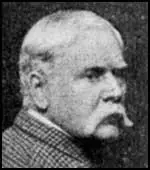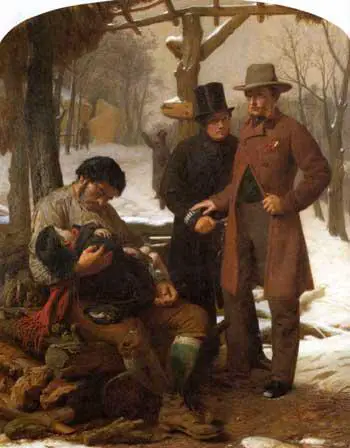Marcus Stone

Marcus Clayton Stone, the third of four children of Frank Stone and Elizabeth Stone, was born in London on 4th July 1840. His father was a watercolourist and was a close friend of Charles Dickens, William Makepeace Thackeray , Wilkie Collins and Daniel Maclise.
Marcus often visited the Dickens household. In 1852 he drew a sketch from Bleak House, which he presented to the author. Dickens inscribed his thanks on a copy of his book A Child's History of England, writing "you have made an excellent sketch from a book of mine which I have received (and preserved) with great pleasure". His biographer, Pamela M. Fletcher, has pointed out: "While Stone had no formal artistic training he learned the trade in his father's studio." Marcus also attended life-drawing class held by established artists, including William Powell Frith, Augustus Egg and William Holman Hunt.
1857 Collins and Dickens wrote The Frozen Deep. The inspiration for the play came from the expedition led by Rear-Admiral John Franklin in 1845 to find the North-West Passage. Dickens offered to arrange its first production in his own home, Tavistock House. Dickens also wanted to play the part of the hero, Richard Wardour, who after struggling against jealousy and murderous impulses, sacrifices his life to rescue his rival in love. Dickens, also gave parts to three of his children, Charles Culliford Dickens, Kate Dickens, Mamie Dickens and his sister-in-law, Georgina Hogarth. The seventeen year old Marcus Stone was also given a part in the play.
After the death of Frank Stone Dickens tried very hard to help Marcus's career. He recommended him to his publishers, Chapman and Hall, with the words, "he is an admirable draughtsman, has a most dexterous hand, a charming sense of grace and beauty, and a capital power of observation". Valerie Browne Lester has pointed out: "After Frank Stone died in 1859, Dickens took the rest of his old friend's family under his wing, and gave Frank's son, Marcus, a leg-up in the publishing world by recommending him to Chapman and Hall."
In 1859 Stone exhibited Silent Pleading at the Royal Academy. The painting shows a tramp, a policeman and a country gentleman. The tramp, who has a child wrapped up in his cloak, has taken shelter from the snowy weather; the policeman is about to arrest him but it appears as if the gentleman is suggesting that he should be left alone. The Art Journal praised the painting for its "earnestness and simplicity". Julian Treuherz, the author of Hard Times: Social Realism in Victorian Art (1987) has argued: "Its subject can be explained from his friendship with Charles Dickens, an intimate companion and neighbour of his father."

Charles Dickens did what he could to help Stone and in 1861 he commissioned him to produce a frontispiece to Little Dorrit. Two years later he employed him to provide the illustrations for Our Mutual Friend . The experienced Hablot Knight Browne had illustrated Dickens books for nearly 30 years. When he heard the news he wrote to Robert Young about the decision: "Marcus is no doubt to do Dickens. I have been a good boy, I believe. The plates in hand are all in good time, so that I do not know what's up, any more than you. Dickens probably thinks a new hand would give his old puppets a fresh look, or perhaps he does not like my illustrating Trollope neck-and-neck with him - though, by Jingo, he need fear no rivalry there! Confound all authors and publishers, say I. There is no pleasing one or the other. I wish I had never had anything to do with the lot."
Peter Ackroyd has argued that Dickens had not been happy with Browne's illustrations for A Tale of Two Cities: "His work for Dickens had been falling off, and his illustrations for A Tale of Two Cities were woefully sketchy and undramatic. He had also been appearing in many different places, which cannot have helped him concentrate upon his Dickensian contributions. The really important fact remains, however, that the particular symbiotic relationship between writer and artist had now disappeared; Dickens no longer needed Browne to give visual strength to his imaginative conceptions, and Browne had ceased to develop and enlarge his range in response to Dickens's own progress as an artist. A separation was, in that sense at least, understandable.... Marcus Stone was younger and fresher than Hablot Browne, but by no means so good an artist... Dickens wanted a new look for his first serial novel in seven years... His work was much more contemporary and much more fashionable - more modern."
Marcus Stone also did work for Anthony Trollope and illustrated his serialized novel, He Knew He Was Right (1868–9). This was not considered a success and after this he concentrated on painting and was a regular exhibitor at the annual Royal Academy show. Alfred Lys Baldry argued in The Life and Work of Marcus Stone (1896): "He (Marcus Stone) is an admirable draughtsman, has a most dexterous hand, a charming sense of grace and beauty, and a capital power of observation".
Pamela M. Fletcher argues: "Stone's success and reputation, however, were primarily based on the romantic genre scenes that he began painting in the mid-1870s. These works depict proposals, lovers' quarrels, and moments of reverie among the upper classes of the early nineteenth century, a period he chose for its combination of picturesque costume and relative familiarity." In 1899 Stone admitted: "I had always been a great student of history... but a student with a political bias. I had come to the conclusion that history as written by the historian was a very different thing from that which was written by the people who made it… the kings and nobles were very great and grand and quite different from ordinary human beings." According to The Times, Stone was "a a militant Radical, alike in politics and religion."
Marcus Stone died at his home, 8 Melbury Road, Kensington, London, on 24th March 1921.
Primary Sources
(1) Hablot Knight Browne , letter to Robert Young (1863)
Marcus is no doubt to do Dickens. I have been a good boy, I believe. The plates in hand are all in good time, so that I do not know what's up, any more than you. Dickens probably thinks a new hand would give his old puppets a fresh look, or perhaps he does not like my illustrating Trollope neck-and-neck with him - though, by Jingo, he need fear no rivalry there! Confound all authors and publishers, say I. There is no pleasing one or the other. I wish I had never had anything to do with the lot.
(2) Peter Ackroyd, Dickens (1990)
His (Hablot Knight Browne) work for Dickens had been falling off, and his illustrations for A Tale of Two Cities were woefully sketchy and undramatic. He had also been appearing in many different places, which cannot have helped him concentrate upon his Dickensian contributions. The really important fact remains, however, that the particular symbiotic relationship between writer and artist had now disappeared; Dickens no longer needed Browne to give visual strength to his imaginative conceptions, and Browne had ceased to develop and enlarge his range in response to Dickens's own progress as an artist. A separation was, in that sense at least, understandable.... Marcus Stone was younger and fresher than Hablot Browne, but by no means so good an artist... Dickens wanted a new look for his first serial novel in seven years... His work was much more contemporary and much more fashionable - more modern.
